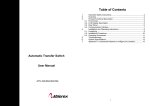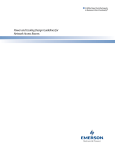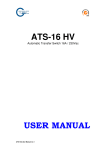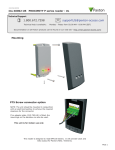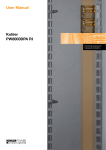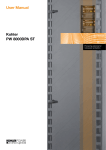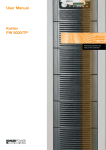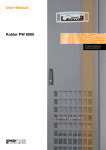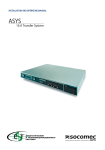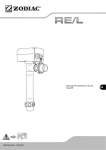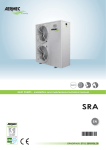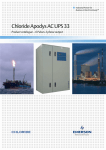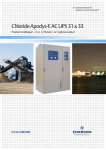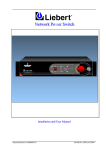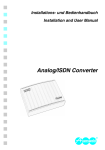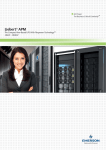Download Liebert® NETWORK POWER SWITCH 2™
Transcript
AC Power For Business-Critical ContinuityTM Liebert® NETWORK POWER SWITCH 2™ Installation Manual – 7,3 KVA – 230V –32A – 2 Pole TM Dear Customer, Please accept our thanks for giving us the privilege to serve you by choosing a Liebert make product. If this is your first Liebert product, we hope it is the beginning of a long relationship which delivers value to your organisation. If you already own and use a Liebert product, we are doubly honoured by your decision of continuing this relationship. It is our constant endeavour to partner you for the growth and success of your business. This philosophy is reflected in our Mission statement “To deliver value through Air & Power Quality solutions to achieve customer delight”. Please do give us feedback to help us realize our Mission. Emerson Network Power User Manual Network Power Switch 2 Information for the protection of the environment 1.Unit servicing: this unit makes use of components dangerous for the environment (electronic cards, electronic component). The components removed must be taken to specialized collection and disposal centers. 2.Unit dismantling: in case of unit dismantling, this operation shall be carried out by specialized personnel. The unit must be taken to centers specialized in collection and disposal of dangerous substances. (08/10) User Manual Network Power Switch 2 ENGLISH This manual describes installation and operation procedures for the Network Power Switch 2. All relevant parts of the manual should be read prior to commencing installation. If you encounter any problems with the procedures contained in this manual you should seek immediate assistance from the Liebert Sales Office from whom the equipment was purchased. Alternatively, contact the Liebert's Customer Service & Support department at the address shown below: EMERSON NETWORK POWER S.r.l. (HQ) Customer Service and Support Department Via Leonardo da Vinci 16/18 35028 - Piove di Sacco (PD) Italy Help Desk Telephone +39 049 9719233 Fax +39 049 9719053 mailto:[email protected] While every precaution has been taken to ensure accuracy and completeness in this manual, Liebert Corporation assumes no responsibility and disclaims all liability for damages resulting from use of this information or for any errors or omissions. This document and the contents herein are confidential and the sole property of Emerson. Reproduction, distribution or unathorized use of this document or any parts within this document are forbidden without the written consent of Emerson. Liebert Corporation pursues a policy of continual product development and reserves the right to change the equipment design without notice. Copyright 2010 by Liebert Corporation. Unauthorized reproduction prohibited All rights reserved. (08/10) Page i User Manual Network Power Switch 2 Table of Contents 1 Chapter 1 – General description ................................................................................................................................1-1 1.1 1.2 1.3 1.4 1.5 1.6 2 Introduction...........................................................................................................................................................1-1 Design Concept.....................................................................................................................................................1-1 Mechanical Design Description ...........................................................................................................................1-2 Mimic Indications .................................................................................................................................................1-3 Manual Bypass Switch Operation ........................................................................................................................1-4 Potential free contacts...........................................................................................................................................1-5 Chapter 2 – Operating Instructions............................................................................................................................2-1 2.1 2.2 2.3 2.4 2.5 3 Introduction...........................................................................................................................................................2-1 General Notes........................................................................................................................................................2-1 Procedure for Switching the Network Power Switch to power the load from a Power Off condition...............2-2 Switching the Load to Manual Bypass condition ................................................................................................2-2 Procedure for switching the Network Power Switch from Manual Bypass condition to Normal Operation ....2-3 Chapter 3 – Installation Procedure ............................................................................................................................3-3 3.1 3.2 3.3 3.3.1 3.3.2 3.3.3 3.3.4 3.3.5 3.3.6 3.4 3.4.1 3.4.2 4 Chapter 4 – Specifications .........................................................................................................................................4-1 4.1 4.2 4.3 4.4 4.5 5 Introduction...........................................................................................................................................................3-3 Equipment positioning and environmental considerations..................................................................................3-3 Connecting cables to Network Power Switch......................................................................................................3-4 Cable entry ........................................................................................................................................................3-4 Cable Rating ......................................................................................................................................................3-1 Cable connections .............................................................................................................................................3-1 Safety earth........................................................................................................................................................3-2 Protective devices..............................................................................................................................................3-2 Cabling Procedure.............................................................................................................................................3-3 Removal and Fixing of Hotswap unit ..................................................................................................................3-3 Removal of Hotswap unit .................................................................................................................................3-3 Fixing of Hotswap unit .....................................................................................................................................3-4 Conformity and Standards....................................................................................................................................4-1 General Specifications ..........................................................................................................................................4-1 Environmental specifications ...............................................................................................................................4-1 Electrical Specifications .......................................................................................................................................4-2 Mechanical specifications.....................................................................................................................................4-2 Installation Drawings .................................................................................................................................................5-1 5.1.1 5.1.2 5.1.3 5.1.4 5.1.5 5.1.6 5.1.7 5.1.8 5.1.9 Power Circuit Diagram – Controller PCB........................................................................................................5-2 Power Circuit Diagram – RC Snubber PCB ....................................................................................................5-3 External power cable connections ....................................................................................................................5-4 Overall general arrangement.............................................................................................................................5-5 Connection of the external isolators utilizing users external power supply ....................................................5-6 External Power Supply realization for 230VAC shunt trip coils....................................................................5-7 External Power Supply realization for low voltage AC shunt trip coils..........................................................5-8 External Power Supply realization for DC shunt trip coils..............................................................................5-9 Circuit breaker selection chart ....................................................................................................................... 5-10 LIMITED WARRANTY ................................................................................................................................................ 5-11 (08/10) Page i User Manual Network Power Switch 2 This manual describes the following equipment: EQUIPMENT 7,3kVA, 230V, 32A, 2 Pole Network Power Switch PART NUMBER SSWITCH2-32A Support Information: If you require assistance for any reason, please have the following information available: Model and size Serial number Date installed Location Voltage & Frequency (08/10) Page ii User Manual Chapter 1 - General Description Network Power Switch 2 1 Chapter 1 – General description 1.1 Introduction The Network Power Switch (NPS) is an automatic static transfer switch designed to provide fast automatic transfers between two independent, synchronous/asynchronous AC power sources to provide continuity of AC power to critical equipment, such as information technology equipment. One of the two AC inputs is designated as the “preferred” source to which the Network Power Switch will connect the load as long as the designated input source is within the acceptable limits. The Network Power Switch is designed to transfer the output load to the “alternate “input source, as long as the alternate source is within the acceptable voltage limits and the preferred source is not. The Network Power Switch provides fast, break-before-make transfers to prevent interconnection of the two sources, even under faulted source conditions. The maximum sense and transfer times are within the tolerance of IEEE Standard 446 susceptibility curve for information technology equipment to allow uninterrupted load equipment operation. In case of overload, Network Power Switch gives the alarm. Under Short-circuit condition a fast acting semi conductor fuse protects condition of the load. The Network Power Switch is 2 pole switch to prevent objectionable currents in the earth due to separate grounding systems for the two sources. Manual Bypass Switch The entire power static switch module is hot swappable. Before removing this module the load is transferred, without break to any one of the source directly by using the Manual bypass switch. After replacing the static switch module, the load is restored on static switch module, using the Manual bypass switch. Block Diagram Fig 1.1 – Block Diagram of Network Power Switch (08/10) Page 1-1 User Manual Chapter 1 - General Description Network Power Switch 2 1.2 Design Concept Fig 1.2 - Power Circuit Diagram for Network Power Switch Figure 1.2 shows the Power circuit diagram for Network Power Switch. Source 1 & Source 2 are the two synchronized/unsynchronized power sources with fuse switches FS1 & FS2 & pair of SCR’s TA1 & TB1 in series with each path &TA2 and TB2 in the neutral path Logic dictates that at any time only one pair of back-to-back connected SCR’s in the line and neutral should conduct. This routes the input power to the output load. Should the load feeding source fail due to any reason; the other source takes over automatically in less than 6 ms in case of synchronized sources and in less then 16 ms in case of unsynchronized sources. The change over is always with break, which ensures that in no case two sources get paralleled. Priority source can be selected through front panel switch. The live mimic on front panel indicates which source is on priority & which is feeding the load. Figure 1.4 shows the details of live mimic panel. (08/10) Page 1-1 User Manual Chapter 1 - General Description Network Power Switch 2 1.3 Mechanical Design Description Fixed unit Hotswap unit Manual Bypass Switch Lock Telescopic Slides Fig 1.3 – Hotswap and Fixed Unit The Network Power Switch consists of two modules. The fixed unit consists of the input and output connections and manual bypass transfer control switch. The second module is hot swappable plug-in type with removable electronics & static switching module. The Manual Bypass switch is located on the right side of the cabinet with a key lock to restrict access to qualified or designated operators. The Hotswap contains locked latches to prevent unauthorized removal of the module. The Network Power Switch is designed to allow replacement of the removable electronics /switching module without having to de-energize the load equipment. The Entire power static switch module is detachable. Before removing this module the load is transferred without break to any one of the source directly. After replacing the static switch module, the load is again transferred back to Network Power Switch without break. Refer to section 3.4 for safe removal and fixing of Hotswap unit on page 3-5. (08/10) Page 1-2 User Manual Chapter 1 - General Description Network Power Switch 2 1.4 Mimic Indications S1 Healthy S1 Priority S1 Feeding Load on S1 Priority Selection Switch Overload Load on S2 Unsynchronised transfer S2 Healthy S2 Priority S2 Feeding Fig 1.4 – Mimic and LED Indications LED INDICATION Mimic indications: Ten LED’s are mounted on the mimic plate; Glowing LED’s indicate the status of the Network Power Switch. S1 Healthy: Source –1 is a healthy source and is well above the 10% under voltage setting. S2 Healthy: Source –2 is a healthy source and is well above the 10% under voltage setting. S1 Priority: The priority selector switch is on S1 priority position. S2 Priority: The priority selector switch is on S2 priority position. S1 Feeding: The load is fed through source -1. S2 Feeding: The load is fed through source -2. Overload: Overload has occurred i.e. current level crossed 110% of full load. Unsynchronized: The sources are out of phase-synchronized window. Load on S1: Source –1 is feeding the load. Load on S2: Source –2 is feeding the load. (08/10) Page 1-3 User Manual Chapter 1 - General Description Network Power Switch 2 1.5 Manual Bypass Switch Operation Load feed through source 1 BYPASS Load feed through NPS OUTPUT Load feed through source 2 BYPASS Fig 1.5 – Manual Bypass Switch Operation Manual Bypass switch is used only when a fault occurs in the Network Power Switch and the control circuitry of the Network Power Switch is to be checked. To perform this operation the load is connected to the bypass. For Normal Operation, the position of the switch should be at Network Power Switch output position (i.e. horizontal) If the load is to be fed through the source 1 Bypass, first it is to be unlocked and the knob should be rotated upwards. To feed through source 2 bypass the knob is to be rotated downward. A mechanical interlocking arrangement is provided on this Bypass switch, by which the Hot swappable unit can be removed only when load is connected to bypass. In normal operation when the load is connected to Network Power Switch, the Hot swappable unit cannot be removed. Operating Network Power Switch in Bypass mode • Unlock the Manual Bypass Switch with the key provided. • Depending upon the available healthy source (i.e. either Source-1 or Source-2 ) select it by changing the Manual Bypass Switch position. Because of the make-before-break operations of the switch it is necessary to select the bypass line on the source, which was feeding the output of the NPS previously, otherwise the unsynchronized sources will be shorted resulting in fuse(s) blow. • Unlock the sliding module (08/10) Page 1-4 User Manual Chapter 1 - General Description Network Power Switch 2 Pull out the Hot swappable sliding module out of the Network Power Switch, which contains SCR assembly and control circuitry. • Operating Network Power Switch in Normal Mode (load connected to Network Power Switch output) • Insert the Hot swappable module into the Network Power Switch unit • Lock the sliding module for preventing its accidental opening. • Unlock the Manual Bypass Switch with the key provided • Connect the Load output to Network Power Switch by changing the switch position to Network Power Switch output. • Depending on the priority switch, Load will get transferred to source-1, if the priority switch is on source1. • The Static Switch output position LED will glow 1.6 Potential free contacts The Network Power Switch status can be checked on the connectors located on the rear end, as shown in figure 1.6. Two potential free contacts indicating Source 1 and Source 2 Healthy conditions are taken from controller board and terminated at rear terminal connectors, as shown in figure 1.6. These two voltage free contacts are Normally Open (NO) and their rating is 1A / 2A @ 120Vac / 24Vdc. Fig 1.6 – Potential free contacts Connectors Way of using the Potential Free Contacts (PFC) Source Healthy Signals a) Independent b) Parallel c) Series 51 50 52 52 52 50 50 51 51 The potential free contacts can be used in the above drawn way (08/10) Page 1-5 User Manual Chapter 1 - General Description Network Power Switch 2 Optional: 1NO + 1NC Auxiliary contact block stackable to siemens circuit breaker Auxilliary Backfeed indication contact: 13 21 22 14 Note : a) The line shows PFC inside NPS b) The numbers indicated in the boxes are wire numbers coming to PFC terminals 2 Chapter 2 – Operating Instructions 2.1 Introduction The Network Power Switch can be considered to be in one of the three operating conditions: • Normal Operation - All relevant power switches and fuses closed and the Load is connected to Network Power Switch output • Manual Bypass – The load is connected to the input supply directly. • Shut down - All power switches are off and load is not operational. • Blown Fuse – One or both of the input fuses are blown. Before replacing with the fuse(s) of the prescribed type it is recommended to check if there is no short circuit present on the output. If the failure condition is repeated even after verifying there is no short circuit present at the output it is necessary to contact the service. • Backfeed failure : Faulty condition when the unit isolated the source connected to faulty internal switch – to resolve the error it is necessary to contact the service. The controlled isolation of the source due this reason is indicated also via the status of BF dry contacts (Optional for CB). 2.2 General Notes NOTE: All users controls and indicators mentioned in these procedures are identified in chapter1 Fig 2.1 - Power Connection details for Network Power Switch (08/10) Page 2-1 User Manual Chapter 1 - General Description Network Power Switch 2 2.3 Procedure for Switching the Network Power Switch to power the load from a Power Off condition This procedure should be followed when turning on the Network Power Switch from a fully powered down condition -i.e. When the load is not being initially supplied at all. It is assumed that the installation is complete; the authorized personnel have commissioned the system. 1. Select the priority to source1. Close the fuse FS1. 2. Check for the LED S1 healthy, S1 priority, S1 feed and LED load on source1 to glow. 3. Close the fuse FS2. 4. Check for the LED S2 healthy to glow. 5. Using priority switch transfer the load to source2, check this transfer does not affect the load. 6. Transfer the load to source 1 again and check this transfer does not affect the load. 2.4 Switching the Load to Manual Bypass condition Bypass on S1 SOURCE Yellow LED (Load on S1) Yellow LED (Load on S2) ‘ON’ Bypass on S2 SOURCE Load connected to this bypass Fig 2.2 – Switching to Bypass WARNING This operation should be performed by Trained personnel only. SWITCH TO YELLOW LED ‘ON’ POSITION ONLY. 1. By seeing the LED indication check which source is feeding. 2. Unlock the Bypass switch lock by the using the key provided. 3. Rotate the Manual Bypass switch in the direction of the source feeding the load as per the warning given on the mimic. 4. Relock the Bypass switch, remove the key and keep it in original place. (08/10) Page 2-2 User Manual Chapter 1 - General Description Network Power Switch 2 2.5 Procedure for switching the Network Power Switch from Manual Bypass condition to Normal Operation 1. Unlock the Bypass switch using the key provided. 2. Rotate the bypass switch knob to the Static switch output position, i.e. horizontal position. 3. Lock the Bypass Switch, remove the key and keep it in original place. 3 Chapter 3 – Installation Procedure 3.1 Introduction WARNING Do not apply electrical power to the Network Power Switch equipment before the arrival of the commissioning engineer. See installation instructions before connecting to the supply. WARNING The Network Power Switch equipment should be installed by a qualified engineer in accordance with the information contained in this chapter and the drawing package shipped inside UPS cabinet. This chapter contains information regarding the positioning and cabling of the Network Power Switch. Because every site has its peculiarities, it is not the aim of this chapter to provide step-by-step installation instructions, but to act as a guide to the general procedures and practices that should be observed by the installing engineer. 3.2 Equipment positioning and environmental considerations The Network Power Switch cabinets are designed to fit in standard 19-inch rack. In case of non-availability, it can be kept on floor or as a tabletop item, with sufficient ground clearance. Network Power Switch should be located in a cool, dry, clean environment with adequate ventilation to keep the ambient temperature within the specified operating range. WARNING The Network Power Switch cabinet is connected with live voltages, hence it should be located at safe place. To ensure efficient cooling 1U free space above the unit is necessary For installing the NPS in standard 19” Rack, remove the Nuts used for ‘Safety Clamps’ as shown in the figure 3.1. After keeping the NPS cabinet inside the rack, fix the cabinet with Safety Clamps intact, using same screws. (08/10) Page 3-3 User Manual Chapter 1 - General Description Network Power Switch 2 Fig 3.1 – NPS Installation 3.3 Connecting cables to Network Power Switch WARNING BEFORE CABLING-UP THE NETWORK POWER SWITCH, ENSURE THAT YOU ARE AWARE OF THE LOCATION AND OPERATION OF THE EXTERNAL ISOLATORS THAT CONNECT THE NETWORK POWER SWITCH INPUT SUPPLY TO THE MAINS DISTRIBUTION PANEL. CHECK THAT THESE SUPPLIES ARE ELECTRICALLY ISOLATED, AND POST ANY NECESSARY WARNING SIGNS TO PREVENT THEIR INADVERTENT OPERATION. HIGH LEAKAGE CURRENT EARTH CONNECTION ESSENTIAL BEFORE CONNECTING SUPPLY. 3.3.1 Cable entry Cables enter the Network Power Switch cabinet from the rear side as shown in figure 3.2. The cables are terminated on the connectors and fuses. Fig 3.2 – Cable Entry (08/10) Page 3-4 User Manual Chapter 1 - General Description Network Power Switch 2 3.3.2 Cable Rating Following are the recommended cable size for 7,3kVA Network Power Switch – Table 3-1 Description Input Cables Output Cables Signalization&coil drive PVC cable (mm2)* 3G6 3G6 10 x 0,25 ** Max Cable (mm2) 3G10 3G10 - Recommended cable size for Input & Output terminals (CTS10U) is 1.5 to 10 mm2. Higher dimension limited by cable gland capability * ** Note: • • Max. Current rating (Amp) 32 32 2 It is recommended to use cables with suitable lugs to avoid any short circuit between terminals. These recommendations are for guideline purposes only and may be superseded by local regulations and codes of practices. Fig. 3.3 – External cable routing 3.3.3 Cable connections Following are the set of external power cables, which are connected to the Network Power Switch equipment – • • • • • • • • • Input source 1 – Line 1 Input source 2 – Line 2 Input source 1 – Neutral 1 Input source 2 – Neutral 2 Output – Line Output – Neutral Earthing ( PE ) External shunt trip coil drive contacts Source state signalization (Source Healthy) These cables are connected to the terminals on rear side of the equipment as shown in fig 3.4 (08/10) Page 3-1 User Manual Chapter 1 - General Description Network Power Switch 2 Fig 3.4 – External Power Cables 3.3.4 Safety earth The safety earth terminal is provided on the rear side of equipment .The safety earth cable of the inputs and the output must be connected to this terminal. WARNING FAILURE TO FOLLOW ADEQUATE EARTHING PROCEDURES CAN RESULT IN ELECTRIC SHOCK HAZARD TO PERSONNEL, OR THE RISK OF FIRE, SHOULD AN EARTH FAULT OCCUR. 3.3.5 Protective devices For safety reasons, it is necessary to install external to the Network Power Switch system, circuit breaking protective devices in the input a.c. supply and towards the output. Given that every installation has its own characteristics, this chapter provides general useful information for qualified installation engineers, with knowledge of operating practices, of regulatory standards, and of the equipment to be installed. Rectifier and Bypass input supply of the Network Power Switch: The input to Network Power Switch should be given through a 32A, 2 Pole ELCB for safe operation. Protection against excessive over currents and short-circuits in the mains supply input: These inputs must be protected, installing suitable protective devices at the distribution panel of the incoming main supply, considering that the protection should discriminate with overload capacity of the system. The protective devices must be selected for the nominal input current, with respect to the rating and the input a.c. supply voltage as given in table 3-1 Protection against earth faults (RCD or RCCB devices): In the event of a differential (RCD) device being installed upstream of the input supply, one must take into account the transient and steady state earth leakage currents that are produced during start-up of the Network Power Switch. The presence of an RFI suppression filter inside the Network Power Switch determines a residual earth current not greater than 3.5mA. Residual current circuit breakers (RCCB / RCD) must be sensitive to d.c. unidirectional pulses (class A) in the network and insensitive to transient current pulses. Thy are identified by the symbols respectively: (08/10) Page 3-2 User Manual Chapter 1 - General Description Network Power Switch 2 These isolators must have an average sensitivity, possibly adjustable between 10mA and 0.3A; further more the intervention of the RCD’s have to be delayed of > 90 ms. Output to the System: In the event that an external distribution panel is used for load distribution, the selection of protective device must provide discrimination with those that are used at the input to the Network Power Switch module. 3.3.6 Cabling Procedure The external power cables should be connected to the terminals as shown in fig 3.2. Proper termination labels are provided near each connector for ease of cabling. 3.4 Removal and Fixing of Hotswap unit WARNING Hotswap unit should be opened by trained person only as it is connected to live load. This equipment receives power from more than one source. Disconnect output and all input sourcesn of power from this equipment before servicing. NPS is designed for quick and easy maintenance / serviceability. The SCRs and control circuitry is located inside the Hotswap unit. Hotswap unit is connected to the main body by a pair of telescopic slides on left and right side, and power connector at rear end. This Hotswap unit is easily removable by pulling out the handle, which is located in the front. Since it is dangerous to pull out the Hotswap unit when NPS is connected to load, an interlocking arrangement is provided. 3.4.1 Removal of Hotswap unit Following is procedure for safe removal of Hotswap unit: 1. Transfer the load to healthy Bypass by using Maintenance Bypass switch. Refer section 2.4, page 2-2 for details. 2. Remove the Safety clamps. Refer section 3.2 on page 3-1 for details. 3. Pull out the Hotswap unit using the handle located in front. The movement will get restricted at certain distance, which ensures that the Hotswap unit does not fall down in open condition. 4. A small plastic lever is located inside both telescopic slides. Press the left lever downwards and right lever upwards, as shown in fig 3-3. This will unlock the slide and Hotswap unit can be pulled out completely. (08/10) Page 3-3 User Manual Chapter 1 - General Description Network Power Switch 2 Right Telescopic Slide Left Telescopic Slide Fig 3.5 – Removal of Hotswap unit 3.4.2 Fixing of Hotswap unit After ensuring the Hotswap unit is in good ready-to-use condition, it has to be fitted back into the Network Power Switch. Following is procedure for fixing back the Hotswap unit to NPS: 1. Align the Hotswap unit by locating telescopic slide on Hotswap unit with telescopic slide on main body. 2. Press the Hotswap unit into the NPS body, ensuring the proper mating of telescopic slides. 3. Push the Hotswap unit sufficiently to make firm contact with the rear power connector. S1 / S2 Priority LED will glow immediately, followed with S1 & S2 healthy LEDs (as per availability). 4. Transfer the Load to Network Power Switch output from bypass condition. Refer section 2.5, page 2-2 for details. 5. Fit the Safety clamps back to its location and fix the NPS cabinet to Rack (if rack mounted (08/10) Page 3-4 User Manual Chapter 4 – Specifications Network Power Switch 2 4 Chapter 4 – Specifications 4.1 Conformity and Standards This equipment complies with the following requirements: Normative references: Safety: * EN 62310-1 EMC: * EN62310-2 The equipment must be installed in accordance with these instructions and used only with accessories approved by the manufacturer to maintain conformity with the standards. 4.2 General Specifications • • • • • • • • • • • • Manual and Automatic Transfers Sense and transfer time – less than 6 milliseconds Break-Before make switching Selectable preferred source Selectable auto/manual retransfer In-phase transfer window – adjustable from 5 ± 1° Convection cooling Hot swappable electronic static switching module Live mimic on Hot swappable unit for indicating load supply status & alarms Make before break manual bypass switch to transfer load from static switch to direct source 1 or source 2 Isolated neutrals Backfeed Protection and Open SCR Detection1 4.3 Environmental specifications ENVIRONMENTAL CHARACTERISTICS 1 UNITS DESCRIPTION Heat dissipation W 100 Storage temp. range °C -40 to 60°C Operating temp. range °C 0 to 25°C Relative humidity % 0 to 95% Operating altitude m Up to 1500m (5,000 ft) Storage / Transport Altitude m Up to 12000m (40,000 ft) Audible Noise db < 45 db at 1.5 m For synchronous sources only. (08/10) Page 4-1 User Manual Chapter 4 – Specifications Network Power Switch 2 4.4 Electrical Specifications ELECTRICAL CHARACTERISTICS UNITS DESCRIPTION Nominal Input Voltage Volts Nominal Output current Amps 220, 230 or 240 volts singe phase, 3W+G, 50 Hz. Solidly grounded power sources 32 Frequency Source unhealthy status - 50 / 60 Guaranteed Transfer to alternate source within –15 % of Vnominal Load Power factor range - 0.5 to unity leading or lagging Load Crest factor - Up to 3.5 In-Phase transfer window - Adjustable from 5 ± 1º Source voltage distortion % up to 10% THD Overload capability % 125% of continuous current for 10 minutes, 1000% for two cycles minimum. Over current Protection - By semi conductor fuse Short circuit withstand capability Amps Up to 20,000 symmetrical amps, protected by internal fusing. Redundant Control Power supplies - Taken from available source 1 and source 2 Integral Maintenance Bypass - Make before break operation Alarm contacts - Hz Two Potential Free Contacts available at the rear. Transfer time 6 millisecond for synchronized transfer and 16 millisecond for unsynchronized transfer. Relay 2A@250VAC Dry contact fusing externally 2A fuse or circuit breaker 4.5 Mechanical specifications MECHANICAL CHARACTERISTICS UNITS DESCRIPTION Height mm 88.0 Width mm Depth mm Weight kg 431.0 457.0 492.0 if cable gland mounted 8.0 Colour Structure Black Installation Cable entry Ingress Protection (08/10) 19” Rack Mounted / table top - Rear side IP20 Page 4-2 User Manual Network Power Switch 5 Installation Drawings 5.1.1 5.1.2 5.1.3 5.1.4 5.1.5 5.1.6 5.1.7 5.1.8 5.1.9 Power Circuit Diagram – Controller PCB Power Circuit Diagram – RC Snubber PCB External Power cable connections Overall general arrangement Connection of the external isolators utilizing users external power supply External Power Supply realization for 230VAC shunt trip coils External Power Supply realization for low voltage AC shunt trip coils External Power Supply realization for DC shunt trip coils Circuit breaker selection chart (08/10) Page 5-1 User Manual Chapter 5 – Installation Drawing Network Power Switch 5.1.1 Power Circuit Diagram – Controller PCB (08/10) Page 5-2 User Manual Chapter 5 – Installation Drawing Network Power Switch 5.1.2 Power Circuit Diagram – RC Snubber PCB (08/10) Page 5-3 User Manual Chapter 5 – Installation Drawing Network Power Switch 5.1.3 External power cable connections Rear View EXTERNAL POWER CABLE CONNECTION NETWORK POWER SWITCH (08/10) Page 5-4 User Manual Chapter 5 – Installation Drawing Network Power Switch 5.1.4 Overall general arrangement (08/10) Page 5-5 User Manual Chapter 5 – Installation Drawing Network Power Switch 5.1.5 Connection of the external isolators utilizing users external power supply The shunt trip coil voltage has to be available when any of the source inputs of NPS is available. For recommended coil supply realisation see figures below: For 230VAC shunt trip coils connection see 5.1.6 For low voltage AC shunt trip coils see 5.1.7 For DC shunt trip coils see 5.1.8 For circuit breaker rating see section 5.1.9 (08/10) Page 5-6 User Manual Chapter 5 – Installation Drawing Network Power Switch 5.1.6 External Power Supply realization for 230VAC shunt trip coils (08/10) Page 5-7 User Manual Chapter 5 – Installation Drawing Network Power Switch 5.1.7 External Power Supply realization for low voltage AC shunt trip coils (08/10) Page 5-8 User Manual Chapter 5 – Installation Drawing Network Power Switch 5.1.8 External Power Supply realization for DC shunt trip coils (08/10) Page 5-9 User Manual Chapter 5 – Installation Drawing Network Power Switch 5.1.9 Circuit breaker selection chart Resistive load PRODUCT Protection SSWITCH2-25A SSWITCH2-32A Circuit Breaker Circuit Breaker Solid Neutral 1pole 32A char.B 1pole 40A char.B Light inductive load Standard 2pole 32A char.B 2pole 40A char.B (08/10) Solid Neutral 1pole 32A char.C 1pole 40A char.C Standard 2pole 32A char.C 2pole 40A char.C Heavy inductive load Solid Neutral 1pole 32A char.D 1pole 40A char.D Standard 2pole 32A char.D 2pole 40A char.D Page 5-10 User Manual Network Power Switch LIMITED WARRANTY Liebert Corporation extends the following LIMITED WARRANTY to the purchaser and to its customer (collectively referred to as the "Purchaser"): the enclosed Power Protection System (Liebert NPS) and components are free from defects in materials and workmanship under normal use, service, and maintenance FOR A PERIOD OF TWO YEARS FROM THE DATE OF ORIGINAL PURCHASE from Liebert or the Liebert dealer or retailer. THE FOREGOING WARRANTY IS THE ONLY WARRANTY GIVEN AND NO OTHER WARANTY IS PROVIDED, EXPRESS OR IMPLIED, INCLUDING WITHOUT LIMITATION, MERCHANTABILITY OR FITNESS FOR A PARTICULAR PURPOSE. Certain aspects of disclaimers are not applicable to consumer products acquired by individuals and used for personal, family, or household purposes (as distinguished from industrial or other purposes). Local laws may not allow limitations on how long an implied warranty lasts, so the above limitation may not apply to you. This warranty gives you specific legal rights, and you may have other rights which vary according to local law. Certain repairs or services are the responsibility of the Purchaser and the Purchaser is expected to pay for them. This warranty does not extend either to products with removed or altered serial numbers or to any losses or damages due to act of God or source external to the product, misuse, accident, abuse, neglect, negligence, unauthorized modification, alteration, or repair, use beyond rated capacity, or improper installation, maintenance, application or use, including, without limitation, use in a manner contrary to the accompanying instructions or applicable codes. If the Liebert NPS fails to conform with the above warranty within the two year warranty period, Liebert will repair or replace the system, at Liebert's option. Repairs or replacements are warranted for the remainder of the original warranty period. To make a warranty claim, the Purchaser should call a Liebert’s representative to obtain a Returned Goods Authorization number and shipping instructions. Return transportation costs to Liebert are the responsibility of the Purchaser. “LIFE SUPPORT” POLICY This product is not recommended, and the Company will not knowingly sell this product, for use with life support and other designated "critical" devices. ANY SUCH USE BY A USER AUTOMATICALLY VOIDS AND DISCLAIMS ANY AND ALL WARRANTIES, INCLUDING ANY IMPLIED WARRANTY OF MERCHANTABILITY, IMPLIED WARRANTY OF FITNESS FOR A PARTICULAR PURPOSE, AND EXPRESS WARRANTIES THAT THIS PRODUCT WILL CONFORM TO ANY AFFIRMATION OR PROMISE, FOR THIS PRODUCT AND THE USER AGREES THAT IN NO EVENT SHALL THE COMPANY BE LIABLE FOR CONSEQUENTIAL OR INDIRECT DAMAGES. Ensuring The High Availability Of Mission-Critical Data And Applications. Emerson Network Power, the global leader in enabling business-critical continuity, ensures network resiliency and adaptability through a family of technologies—including Liebert power and cooling technologies—that protect and support business-critical systems. Liebert solutions employ an adaptive architecture that responds to changes in criticality, density and capacity. Enterprises benefit from greater IT system availability, operational flexibility and reduced capital equipment and operating costs. Locations Emerson Network Power – Headquarters EMEA Via Leonardo Da Vinci 16/18 Zona Industriale Tognana 35028 Piove di Sacco (PD) ITALY Tel: +39 049 9719 111 Fax: +39 049 5841 257 [email protected] Emerson Network Power – Service EMEA Via Leonardo Da Vinci 16/18 Zona Industriale Tognana 35028 Piove di Sacco (PD) ITALY Tel: +39 049 9719 111 Fax: +39 049 9719 045 [email protected] While every precaution has been taken to ensure the accuracy and completeness of this literature, Liebert Corporation assumes no responsibility and disclaims all liability for damages resulting from use of this information or for any errors or omissions. © 2010 Liebert Corporation All rights reserved throughout the world. Specifications subject to change without notice. ® Liebert is a registered trademark of Liebert Corporation. All names referred to are trademarks or registered trademarks of their respective owners United States 1050 Dearborn Drive P.O. Box 29186 Columbus, OH 43229 Tel: +1 614 8880246 Asia 7/F, Dah Sing Financial Centre 108 Gloucester Road, Wanchai Hong Kong Tel: +852 2572220 Fax: +852 28029250 Manual reference: 6390066U_REV 4_08-2010 Emerson Network Power. The global leader in enabl ing Business-Critical Continuity. Embedded Computing AC Power Connectivity Embedded Power DC Power Monitoring Racks & Integrated Cabinets Services Surge Protection




































